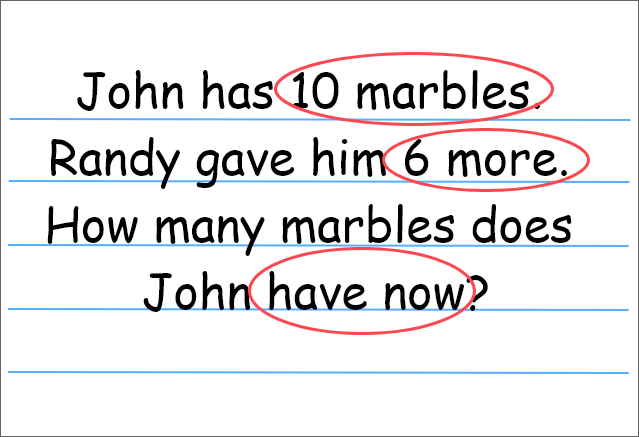How to Solve Add on or Take Away Word Problems
Let's learn to solve real world problems with math like this one.
John has 10 marbles. Randy gave him 6 more marbles. How many marbles does John have now?
There are four steps to solving a word problem.
First, we gather clues.
Next, we draw a picture to figure out what we should do.
👉 We see that we need to do addition to find the whole.
Then, we write an equation, and solve it.
10 + 6 = 16
Finally, we write the answer in a word sentence.
John has 16 marbles now.
👆The problem we just solved is an Add On or Take Away problem.
In Add On or Take Away problems, we start with a number. Then, something happens that will make us either add or subtract. After this, we get a new number.
In our problem, John started with 10 marbles.
Then something happened. Randy gave him 6 more marbles.
👉 So, we added 10 plus 6.
Then, we got 16.
😀Tip: These are some words that can help you know what to do:
If you see the words more, increase, add, in all, and altogether, they all mean "to add".
If you see the words less, decrease, reduced, gave away, take away, and left, they all mean "to subtract".
Another Example
Let's try another problem.
Jim has 12 stickers. He gives 5 stickers to Benny. How many stickers does Jim have left?
Step 1. Gather clues.
We see 12 stickers and 5 stickers.
We see the keywords "gives" and "left".
Step 2. Draw a picture or model.
Based on this picture, what should we do?
We need to find the missing part.
👉 So we subtract the part we know from the total.
We started with 12 stickers. But something happened. Jim gives away 5 stickers.
👉 We subtract 5 from 12.
Step 3. Write an equation and solve it.
12 - 5 = 7
Step 4. Write the answer in a word sentence.
Jim has 7 stickers left.
Great job! 😀
Two-Step Word Problem
Let's solve one more word problem.
12 frogs are in the pond. 2 frogs hop away. Then 5 more frogs hop away. How many frogs are left in the pond?
Step 1. Gather clues.
Step 2. Draw a picture.
We know the whole, and some of the parts that were taken away.
Step 3. Write the equations, or number sentences.
First, we subtract the frogs that hopped away first.
12 - 2 = 10
Then, we subtract the frogs that hopped away next.
10 - 5 = 5
There's another way to solve this.
First, add all the frogs that hopped away.
2 + 5 = 7
Then, subtract the number of frogs that hopped away from the number of frogs we started with.
12 - 7 = 5
We see that we have the same answer.
Step 4. Write the answer in a word sentence.
5 frogs are left in the pond.
Great job!
Now, you're ready to do some practice. 💪
1,000 Create Credits is worth $1 in real AI compute time.
1 Create Credit is enough to get 1 question answered, or to generate 1 image from text, in the tools tab.










